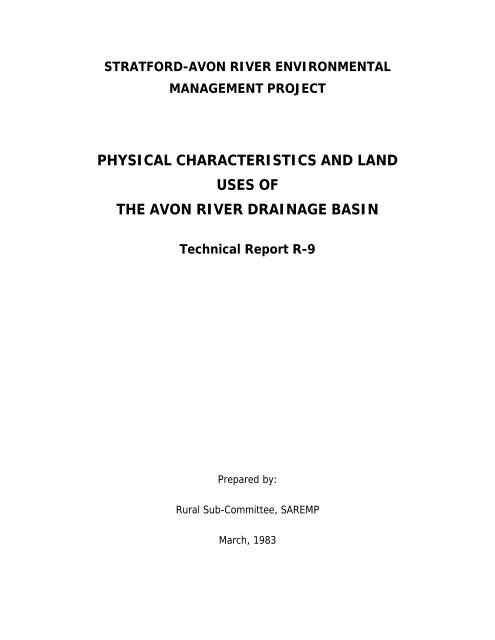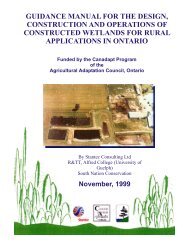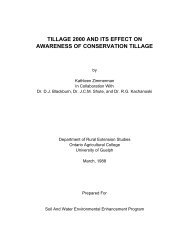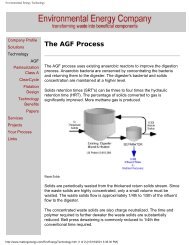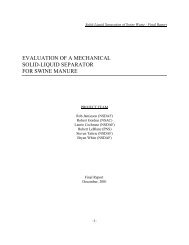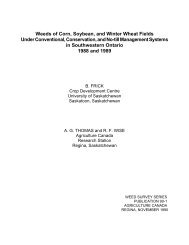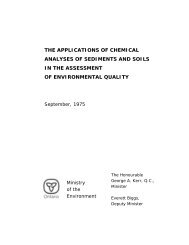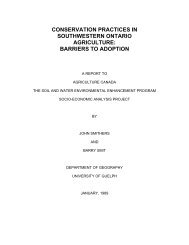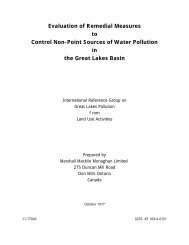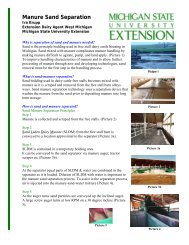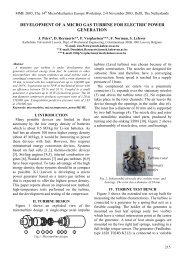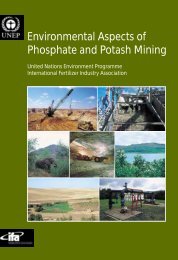Physical Characteristics and Land Uses of the Avon River Drainage ...
Physical Characteristics and Land Uses of the Avon River Drainage ...
Physical Characteristics and Land Uses of the Avon River Drainage ...
- No tags were found...
Create successful ePaper yourself
Turn your PDF publications into a flip-book with our unique Google optimized e-Paper software.
STRATFORD-AVON RIVER ENVIRONMENTALMANAGEMENT PROJECTPHYSICAL CHARACTERISTICS AND LANDUSES OFTHE AVON RIVER DRAINAGE BASINTechnical Report R-9Prepared by:Rural Sub-Committee, SAREMPMarch, 1983
PREFACEThis report is one <strong>of</strong> a series <strong>of</strong> technical reports resulting from work undertaken as part<strong>of</strong> <strong>the</strong> Stratford/<strong>Avon</strong> <strong>River</strong> Environmental Management Project (SAREMP).This two-year project was initiated in April 1980, at <strong>the</strong> request <strong>of</strong> <strong>the</strong> City <strong>of</strong> Stratford.SAREMP is funded entirely by <strong>the</strong> Ontario Ministry <strong>of</strong> <strong>the</strong> Environment. The purpose <strong>of</strong> <strong>the</strong>project is to provide a comprehensive water quality management strategy for <strong>the</strong> <strong>Avon</strong><strong>River</strong> Basin. In order to accomplish this considerable investigation, monitoring <strong>and</strong> analysishas taken place. The outcome <strong>of</strong> <strong>the</strong>se investigations <strong>and</strong> field demonstrations will be adocumented strategy outlining <strong>the</strong> program <strong>and</strong> implementation mechanisms mosteffective in resolving <strong>the</strong> water quality problems now facing residents <strong>of</strong> <strong>the</strong> basin. Theproject is assessing urban, rural <strong>and</strong> in-stream management mechanisms for improvingwater quality.This report results directly from <strong>the</strong> aforementioned investigations. It is meant to betechnical in nature <strong>and</strong> not a statement <strong>of</strong> policy or program direction. Observations <strong>and</strong>conclusions are those <strong>of</strong> <strong>the</strong> authors <strong>and</strong> do not necessarily reflect <strong>the</strong> attitudes orphilosophies <strong>of</strong> <strong>the</strong> agencies <strong>and</strong> individuals affiliated with <strong>the</strong> project. In certain cases <strong>the</strong>results presented are interim in nature <strong>and</strong> should not be taken as definitive until such timeas additional support data is collected.Reference to equipment, br<strong>and</strong> names or supplies in this publication is not to beinterpreted as an endorsement <strong>of</strong> that particular product or supplier.i
Enquiries with respect to this report should be directed to <strong>the</strong> authors or to:Upper Thames <strong>River</strong> Conservation AuthorityP.O. Box 6278, Station 'D'London, OntarioN5W 5S1(519) 451-2800ACKNOWLEDGEMENTSThis report has been compiled <strong>and</strong> updated by D. Hayman <strong>and</strong> M. Fortin. Backgroundinformation on agricultural practices was prepared by W. Caldwell <strong>and</strong> S. Carroll. A.Graham, G. Knight <strong>and</strong> P. Fish provided valuable assistance in various stages <strong>of</strong> reportpreparation. D. Cavender exhibited patience <strong>and</strong> capable effort in <strong>the</strong> typing <strong>of</strong> <strong>the</strong>manuscript.ii
ABSTRACTThe <strong>Avon</strong> <strong>River</strong> <strong>Drainage</strong> Basin, part <strong>of</strong> <strong>the</strong> North Thames Basin, occupies 165 km 2 (64mi 2 ). Eight percent <strong>of</strong> its area is occupied by <strong>the</strong> City <strong>of</strong> Stratford, while agriculturalactivities take up 82% <strong>of</strong> <strong>the</strong> l<strong>and</strong> area. The total population <strong>of</strong> <strong>the</strong> basin was about 27,000in 1980.Most <strong>of</strong> <strong>the</strong> basin straddles <strong>the</strong> Stratford Till Plain but its eastern extremeties extend intoa moraine area. Productive silt-loam soils have developed from <strong>the</strong> parent materials -s<strong>and</strong>y silt till <strong>and</strong> lacustrine clays <strong>and</strong> silts. S<strong>and</strong>s <strong>and</strong> gravels occur in <strong>the</strong> moraine area<strong>and</strong> along <strong>the</strong> river valley.The majority <strong>of</strong> area farms are livestock operations particularly beef or dairy cattle.Therefore, crop rotations with forage are most common. Continuous row crops are,however, an important cropping pattern in <strong>the</strong> basin, one with significant erosion <strong>and</strong>water quality implications. While manure application rates seem to be acceptable, winterapplications are practiced by up to one quarter <strong>of</strong> <strong>the</strong> livestock operators. This could posea threat to water quality. The quality <strong>of</strong> manure storage facilities vary from farm to farm<strong>and</strong> is closely related to <strong>the</strong> size <strong>of</strong> <strong>the</strong> livestock operation.iii
TABLE OF CONTENTSPage1. Introduction 12. <strong>Physical</strong> <strong>Characteristics</strong> 43. <strong>Drainage</strong> Network 94. Population 115. Agricultural Practices 125.1 Farm Operations by Type 145.2 Crops <strong>and</strong> Crop Management 145.3 Manure Generation <strong>and</strong> Management 215.4 Farming Practices along Major Water Courses 25Appendix 1 30References 31iv
LIST OF TABLESPage1. Soils <strong>of</strong> <strong>the</strong> <strong>Avon</strong> Basin 72. Acreages <strong>of</strong> Soil Capability for Agriculture 83. <strong>Drainage</strong> Statistics for <strong>the</strong> <strong>Avon</strong> Basin 104. Farm Enterprises by Type 165. Livestock Operation by Size 176. Cropping Systems 187. Rural L<strong>and</strong> Use <strong>and</strong> Cropping in 1980 198. Timing <strong>of</strong> Manure Applications 249. Manure Storage Facilities 24LIST OF FIGURESPage1. Delineation <strong>of</strong> <strong>Drainage</strong> Areas 22. Political Jurisdictions 33. Bedrock Formations 54. Farm Units 135. Livestock Operations 156. Manure Generation Rates 227. Manure Application Rates 238. Manure Storage Facilities 269. Cattle Access Sites 2810. Livestock Barns Near Major Water Courses 29v
I. INTRODUCTIONThe <strong>Avon</strong> <strong>River</strong> is a small tributary <strong>of</strong> <strong>the</strong> North Thames <strong>River</strong>, located entirely within PerthCounty. Arising in a moraine area to <strong>the</strong> east <strong>and</strong> north-east <strong>of</strong> Stratford, it flows in asouth westerly direction through a level till plain. Eventually it joins <strong>the</strong> North Thames <strong>River</strong>above <strong>the</strong> town <strong>of</strong> St. Marys. The drainage basin <strong>of</strong> <strong>the</strong> <strong>Avon</strong> <strong>River</strong> occupies 165 km 2 (64mi 2 ).Basin l<strong>and</strong>s have experienced a long period <strong>of</strong> human settlement. Principle l<strong>and</strong> uses areagricultural (82%) <strong>and</strong> urban (8%). The developed urban area <strong>of</strong> Stratford exerts adominant influence on <strong>the</strong> <strong>Avon</strong> <strong>River</strong> due to its large size relative to <strong>the</strong> basin area. Evenabove Stratford however, <strong>the</strong> intensity <strong>of</strong> agricultural use results in a water course that isno longer a "natural" stream.This report documents information describing <strong>the</strong> physical <strong>and</strong> human geography <strong>of</strong> <strong>the</strong>area -- including geologic data, soils data, drainage characteristics, population, l<strong>and</strong> uses<strong>and</strong> agricultural practices. The information is organized in terms <strong>of</strong> drainage areas in <strong>the</strong>basin. The basic breakdown for <strong>the</strong>se drainage areas, presented in Figure 1, was governedby <strong>the</strong> location <strong>of</strong> water quality sampling stations established for <strong>the</strong> Stratford-<strong>Avon</strong> <strong>River</strong>Environmental Management Project. Throughout most <strong>of</strong> <strong>the</strong> report <strong>the</strong>se sub-basins areaggregated into upper <strong>and</strong> lower basins. The precise demarcation for <strong>the</strong>se two areas iswater quality station 6 in Stratford. More generally, <strong>the</strong> split coincides with <strong>the</strong> division<strong>of</strong> l<strong>and</strong>s above <strong>and</strong> below Stratford <strong>and</strong> with <strong>the</strong> division <strong>of</strong> rural l<strong>and</strong>s between DownieTownship to <strong>the</strong> West <strong>and</strong> North Easthope, South Easthope <strong>and</strong> Ellice Township to <strong>the</strong> East(Figure 2).1
Figure 2:Political Jurisdictions3
2. PHYSICAL CHARACTERISTICSThe lower basin comprises three separate bedrock formations. The Dundee formation liesin <strong>the</strong> extreme western portion <strong>of</strong> <strong>the</strong> basin. This formation consists <strong>of</strong> two layers. Theupper member is composed <strong>of</strong> medium brown limestone. Below this is a layer <strong>of</strong> lightbrown limestone with quartz s<strong>and</strong> <strong>and</strong> chert. Most <strong>of</strong> <strong>the</strong> lower basin is in <strong>the</strong> LucasFormation comprising Anderson member brown limestone.The Amherstburg formation lies to <strong>the</strong> east <strong>of</strong> <strong>the</strong> Lucas Formation. Here <strong>the</strong> bedrock iscomposed <strong>of</strong> grey <strong>and</strong> dark brown limestone <strong>and</strong> dolomite with localized chert. Thisformation also covers most <strong>of</strong> <strong>the</strong> upper basin. Grey dolomite, limestone <strong>and</strong> chertcharacterize <strong>the</strong> Bois Blanc formation which covers <strong>the</strong> eastern extremity <strong>of</strong> <strong>the</strong> Upperbasin (Figure 3) .Principal l<strong>and</strong> forms <strong>of</strong> <strong>the</strong> area are <strong>the</strong> Stratford Till Plain, which occupies most <strong>of</strong> <strong>the</strong>watershed, <strong>and</strong>, to <strong>the</strong> east, above Shakespeare, <strong>the</strong> Easthope moraine in <strong>the</strong> WaterlooHills physiographic region. The Stratford Till Plain is a level to gently undulating till plainwhich slopes gently to <strong>the</strong> south-west. Local relief on <strong>the</strong> till plain is generally less than 3meters (10 ft.). The Easthope moraine occupies <strong>the</strong> drainage area to <strong>the</strong> east <strong>of</strong> waterquality station 1. Here <strong>the</strong> l<strong>and</strong> is distinctly rolling, <strong>and</strong> relief can exceed 15 meters (50 ft.)The <strong>Avon</strong> <strong>River</strong> arises in two swampy valleys or depressions in <strong>the</strong> Easthope moraine, <strong>the</strong>main one being <strong>the</strong> Gads Hill Swamp. It flows to <strong>the</strong> west following a narrow valley_______________* Material in this section is taken from S.A.R.E.M.P. Technical Report No. S-13, <strong>and</strong> fromCarroll 1981, Karrow 1971, Karrow 1977.4
Figure 3:Bedrock Formations5
associated with a former glacial spillway. Valley walls rise as much as 15 meters (50 ft.)to <strong>the</strong> surrounding till plain, <strong>and</strong> <strong>the</strong> valley itself is generally less than 300 meters (980 ft.)across.Surficial deposits <strong>of</strong> <strong>the</strong> sub-basin west <strong>of</strong> station 1 consist largely <strong>of</strong> Stratford s<strong>and</strong>y silttill interspersed with large pockets <strong>of</strong> lacustrine silt <strong>and</strong> clay. Deposits <strong>of</strong> alluvial <strong>and</strong>outwash gravel, s<strong>and</strong> <strong>and</strong> silt occur along <strong>the</strong> river. Overburden thickness ranges from 15(50 ft.) to 52m (170 ft.) .In <strong>the</strong> upper basin above station 1, overburden thickness is greater, ranging from 37 (120ft.) to 64m (210 ft.). Surficial geology is more complex with areas <strong>of</strong> silty to s<strong>and</strong>y till,Kame s<strong>and</strong> <strong>and</strong> Lacustrine silt <strong>and</strong> clay. Alluvial deposits occur along <strong>the</strong> main drains in <strong>the</strong>area, <strong>and</strong> <strong>the</strong>re are local pockets <strong>of</strong> peat, muck <strong>and</strong> marl.Silt loam soils predominate in <strong>the</strong> <strong>Avon</strong> basin. These are found especially on <strong>the</strong> flatterareas <strong>of</strong> <strong>the</strong> lower <strong>and</strong> upper basins. S<strong>and</strong>y loams are found to <strong>the</strong> east in <strong>the</strong> moraineareas while to <strong>the</strong> west <strong>the</strong>re are some clay loams. Small areas <strong>of</strong> muck <strong>and</strong> bottom l<strong>and</strong>run along <strong>the</strong> main channel. Table 1 gives details <strong>of</strong> <strong>the</strong>se soil types.In general, <strong>the</strong>se soils are imperfectly to poorly drained, with only 20% <strong>of</strong> <strong>the</strong> watershedconsidered well drained. As would be expected, <strong>the</strong>se well drained areas are found largelyin <strong>the</strong> eastern end <strong>of</strong> <strong>the</strong> basin.Agricultural capabilities <strong>of</strong> <strong>the</strong>se soils are quite high. Class 1 l<strong>and</strong> comprises 60% <strong>of</strong> bothDownie <strong>and</strong> North Easthope Townships <strong>and</strong> 50% <strong>of</strong> Ellice Township. About one quarter <strong>of</strong><strong>the</strong>se soils are in Class 2W, which indicates excessive moisture (Table 2).6
TABLE 1.Soils Of The <strong>Avon</strong> BasinSoil/Series Hectares Acres % WatershedWELL DRAINEDHuron Clay Loam Huc 1437 3551 8.7Huron Silt Loam Hus 217 536 1.3Harrison Silt Loam Hsi 1111 2745 6.8 19.6Waterloo S<strong>and</strong>y Loam Wsl 344 850 2.1Donnybrook S<strong>and</strong>y Loam Dsl 114 282 0.7IMPERFECTLY DRAINEDPerth Silt Loam Ps 8050 19892 48.9POORLY DRAINEDBrookston Silt Loam Bsl 3741 9244 22.7Gilford Loam Gil 29 72 0.2 24Parkhill Loam Pl 182 450 1.1VERY POORLY DRAINEDMuck M 617 1525 3.8Bottom l<strong>and</strong> BL 617 1525 3.8 7.6TOTAL 16462 40678 100Source: Caldwell <strong>and</strong> Carroll, 19807
TABLE 2:Acreages Of Soil Capability For Agriculture*Class Class Class Class Class Class Class OrganicTownshipTotals1234567 (0)Downie 29,990 12,030 3,090 235 2,625 340 - 450 48,760Easthope N. 25,795 2,625 8,775 65 4,035 - 2,430 43,725Easthope S. 15,820 3,325 3,640 25 1,150 40 - 130 24,130Ellice 24,075 23,105 3,555 75 2,050 115 - 3,135 56,110Total Acres 95,680 41,085 19,060 400 9,860 495 6,145 172,725Hectares 38,721 16,627 7,713 162 3,990 200 2,487 69,900Source: Caldwell <strong>and</strong> Carroll, 1980* Acreage values are for total township areas.8
3. DRAINAGE NETWORKAs with many <strong>of</strong> Ontario's small agricultural watersheds, <strong>the</strong> <strong>Avon</strong> basin has had anintensive history <strong>of</strong> drainage engineering particularly in <strong>the</strong> early part <strong>of</strong> this century. Infact <strong>the</strong> main channel below Stratford is virtually <strong>the</strong> only remaining natural water course.The tributaries <strong>and</strong> that portion <strong>of</strong> <strong>the</strong> <strong>Avon</strong> <strong>River</strong> above Stratford have all beenchannelized at some time in <strong>the</strong> past.As can be seen from drainage intensity figures in Table 3, <strong>the</strong> greatest rural drainageintensity is found in <strong>the</strong> lower basin where poorly drained soils are found.Owing to <strong>the</strong> presence <strong>of</strong> storm sewers, <strong>the</strong> developed urban area is by far <strong>the</strong> mostintensely drained area in <strong>the</strong> basin. As a result, <strong>the</strong> urban area seems to contribute adisproportionately large amount <strong>of</strong> baseflow to <strong>the</strong> river. For example, <strong>the</strong> 1980 summerbaseflow at station 10 (Federal flow gauge - GD018) was estimated to be 0.35 m 3 sec -1(12.5 ft. 3 /sec.). In contrast, <strong>the</strong> estimated dry wea<strong>the</strong>r storm sewer flow for Stratford was0.10 m 3 sec -1 (3 .5 ft. 3 /s) <strong>and</strong> <strong>the</strong> sanitary effluent flow was 0.20 m 3 sec -1 (7.0 ft. 3 /s).* Thisimplies that <strong>the</strong> rural area above station 10, comprising 12,233 ha.(30,228 acres), yieldedonly 0.05 m 3 sec -1 (1.8 ft. 3 /s) during dry wea<strong>the</strong>r episodes.___________________* Characterization <strong>of</strong> Urban Dry Wea<strong>the</strong>r Loadings, SAREMP Technical Report U-3 (SeeSection 5. Agricultural Practices for format)9
TABLE 3:<strong>Drainage</strong> Statistics For The <strong>Avon</strong> BasinSub-Basins(watermonitoringstations)TotalArea(Ha)UrbanArea(Ha)<strong>Avon</strong>Length <strong>of</strong> Channel (m)PrimaryTributaryO<strong>the</strong>rTributaries*<strong>Drainage</strong>Intensity(10 -4 m -1 )1 (1A) 598 --- 2736 1152 6.52 (1D) 567 --- 5422 10.43 (0-1) 1868 --- 2928 7742 7176 9.64 (1-3) 2378 --- 2328 11160 13080 11.25 (3-5) 3527 152 1824 6192 34208 **12.56 (5-6) --- 6582460(1500=LakeVictoria)130,200(storm sewers)not applicable7 (6-7) 1899 446 1680 4327 13344 **13.88 (7-8) 1186 101 3000 9884 8112 **19.49 (8-9) 899 --- 3120 5661 3200 13.310 (9-10) 360 --- 2904 2352 14.611 (10-11) 650 --- 2328 5472 1944 15.012 (11-12) 1204 --- 1704 1344 18192 17.613 (12-13) 668 --- 3240 5616 13.3Total Rural 15105 27792 66824 99256 12.8* <strong>Drainage</strong> Intensity (DI) = length <strong>of</strong> drains/drainage area (See Appendix 1 for British Units)** For basin 5, 7 <strong>and</strong> 8 <strong>the</strong> DI calculation uses rural area only.10
4. POPULATIONConsidering <strong>the</strong> size <strong>of</strong> <strong>the</strong> <strong>Avon</strong> <strong>River</strong> basin <strong>and</strong> <strong>the</strong> relatively low flows that occur in <strong>the</strong>river, <strong>the</strong> basin is called upon to support a sizeable population - approximately 27,000 in1980. Of this number, 26,300 resided in Stratford (Municipal Directory, 1982). Thebalance, 700 persons, are rural residents <strong>of</strong> Downie, North Easthope, South Easthope <strong>and</strong>Ellice Townships. The population density in Stratford is 19.4 persons per hectare (2.5acres) while in <strong>the</strong> rural area <strong>the</strong>re are 4.7 persons per 100 hectares (250 acres).The rural population was estimated on <strong>the</strong> basis <strong>of</strong> <strong>the</strong> number <strong>of</strong> farm operations within<strong>the</strong> basin, 224 (Caldwell <strong>and</strong> Carroll, 1980) <strong>and</strong> <strong>the</strong> number <strong>of</strong> persons per household,3.24, observed in Downie, Ellice <strong>and</strong> North Easthope Townships (estimated from data in<strong>the</strong> Municipal Directory, 1982). Each farm operation was assumed to correspond to onehousehold in <strong>the</strong> basin.Population growth in <strong>the</strong> rural townships which contain <strong>the</strong> <strong>Avon</strong> basin has been below0.02% per year from 1971 to 1980. Over <strong>the</strong> same period, Stratford's population hasgrown at an average rate <strong>of</strong> 0.7% per year. In <strong>the</strong> past two years <strong>the</strong>re has been nogrowth at all.11
5. AGRICULTURAL PRACTICES *The changes in agriculture which have generally occurred throughout Sou<strong>the</strong>rn Ontarioin <strong>the</strong> second half <strong>of</strong> this century have also had an impact within <strong>the</strong> <strong>Avon</strong> <strong>River</strong>watershed. New technology <strong>and</strong> mechanization has contributed to <strong>the</strong> specialization <strong>of</strong>enterprise type <strong>and</strong> an increase in scale <strong>of</strong> operation. The traditional mixed farmingoperation comprised <strong>of</strong> a small dairy herd, some beef cattle, a few pigs, some hens <strong>and</strong>a regular crop rotation has, in many instances, been replaced by large-scale operations.These include cash cropping operations where, for example, continuous corn is grown,or large-scale livestock operations where expensive methods <strong>of</strong> waste management arerequired. Evidence <strong>of</strong> <strong>the</strong>se changes can be found in <strong>the</strong> fact that farmers in <strong>the</strong> basin areexp<strong>and</strong>ing <strong>the</strong> l<strong>and</strong> base <strong>of</strong> <strong>the</strong>ir operation; out <strong>of</strong> 224 operators, 52 rent or own lotso<strong>the</strong>r than <strong>the</strong>ir principal "home" farm (Figure 4). Generally <strong>the</strong>se changes have increased<strong>the</strong> potential for erosion problems <strong>and</strong> water quality impairment.The following section will examine <strong>the</strong> patterns <strong>of</strong> agriculture in <strong>the</strong> <strong>Avon</strong> watershed <strong>and</strong>some <strong>of</strong> <strong>the</strong> relationships between physical factors, l<strong>and</strong> use <strong>and</strong> water quality problems._______________________* The material in this section is drawn from Caldwell <strong>and</strong> Carroll, 1980 <strong>and</strong> Carroll, 1981.12
Figure 4:Farm Units13
5.1 Farm Operations By TypeThe majority <strong>of</strong> farmers in <strong>the</strong> basin (63%) run livestock operations. Only 16% derivefarm income solely from cash crops, <strong>and</strong> ano<strong>the</strong>r 18% <strong>of</strong> farms are mixed livestock - cashcrop operations. Among <strong>the</strong> livestock <strong>and</strong> mixed operations, dairy farms are <strong>the</strong> mostcommon (31%) followed by beef (16%) swine (16%) <strong>and</strong> combined beef-swine operations(11%). Operation types are detailed in Table 4 <strong>and</strong> 5.The types <strong>of</strong> farm operations tend to differ somewhat across <strong>the</strong> basin. There is a greaterreliance on livestock in <strong>the</strong> upper basin <strong>and</strong> on cash cropping in <strong>the</strong> lower basin (Table4). On <strong>the</strong> o<strong>the</strong>r h<strong>and</strong>, <strong>the</strong> livestock operations in <strong>the</strong> lower basin are more likely to belarger operations involved in only one type <strong>of</strong> livestock (Tables 4 <strong>and</strong> 5). Toge<strong>the</strong>r <strong>the</strong>seobservations imply a greater degree <strong>of</strong> specialization in <strong>the</strong> lower basin although <strong>the</strong>differences are not great.Cash cropping found in <strong>the</strong> lower basin is concentrated largely in <strong>the</strong> area immediatelysurrounding Stratford This is likely <strong>the</strong> result <strong>of</strong> <strong>the</strong> impact <strong>of</strong> urban fringe developmenton rural l<strong>and</strong>.5.2 Crops <strong>and</strong> Crop ManagementCropping practices reflect <strong>the</strong> emphasis on livestock operations. Rotation <strong>of</strong>hay/grain/corn or hay/grain predominate (Table 6). Continuous row cropping with corn<strong>and</strong> beans is <strong>the</strong> next most frequent system. The average length <strong>of</strong> <strong>the</strong> hay/grain/cornrotation is 9 years <strong>and</strong> <strong>of</strong> <strong>the</strong> grain/hay rotation, 8 years. Cash crop rotations average 4to 6 years in length. Beans are grown on <strong>the</strong> till plain areas, especially near <strong>and</strong> belowStratford. Grains <strong>and</strong> hay are more common above Stratford. (Table 7).14
Figure 5:Livestock Operations15
TABLE 4:FARM ENTERPRISES BY TYPEUPPER BASIN* LOWER BASIN* TOTAL- - - - - - - - NUMBER OF OPERATIONS - - - - - - - -A) GENERAL BREAKDOWN:Livestock 96 (68.6%) 45 (54.2%) 141 (63.2%)Mixed 21 (15.0%) 20 (24.1%) 41 (18.4%)B)Cash Crop 20 (14.3%) 16 (19.3%) 36 (16.2%)O<strong>the</strong>r/Minor/No FarmIncome3 (2.1%) 2 (2.4%) 5 (2.2%)Total 140 (100.0%) 83 (100%) 223 (100.0%)Livestock Type inLivestock <strong>and</strong>Mixed Operations:Dairy 32 (26.7%) 26 (40.0%) 58 (31.4%)Beef 21 (17.5%) 8 (12.3%) 29 (15.7%)Swine 18 (15.0%) 11 (16.9%) 29 (15.7%)Poultry 1 (0.8%) -- 1 (0.5%)Dairy <strong>and</strong> Beef 10 (8.3%) 4 (6.2%) 14 (7.6%)Dairy <strong>and</strong> Swine 3 (2.5%) 3 (4.6%) 6 (3.2%)Beef <strong>and</strong> Swine 14 (11.7%) 7 (10.8%) 21 (11.4%)O<strong>the</strong>r 21 (17.5%) 6 (9.3%) 27 (14.6%)Source: Caldwell <strong>and</strong> Carroll* North Easthope, South Easthope <strong>and</strong> Ellice Townships correspond to <strong>the</strong> Upper Basin whileDownie Township comprises <strong>the</strong> Lower Basin.16
TABLE 5: Livestock Operations By SizeUPPER BASIN* LOWER BASIN* TOTAL BASIN- - - - - - - - - - NUMBER OF OPERATIONS** - - - - - - - - - -Dairy1-25 15 (27%) 6 (17%) 21 (23%)26-75 31 (55%) 22 (63%) 53 (58%)76 + 10 (18%) 7 (20%) 17 (19%)Total 56 (100%) 35 (100%) 91 (100%)Beef1-50 34 (67%) 11 (55%) 45 (63%)50-150 15 (29%) 7 (35%) 22 (31%)151 + 2 (4%) 2 (10%) 4 (6%)Total 51 (100%) 20 (100%) 71 (100%)Swine1-100 14 (31%) 3 (13%) 17 (25%)101-300 7 (16%) 4 (17%) 11 (16%)301 + 24 (53%) 16 (70%) 40 (59%)Total 45 (100%) 23 (100%) 68 (100%)Source: Caldwell <strong>and</strong> Carroll, 1980* See note to Table 4.** An operator with two livestock types is counted under each type.17
TABLE 7: Rural L<strong>and</strong> Use <strong>and</strong> Cropping in 1980SUB-BASINS (WaterMonitoring Stations)1,2,3(1A,1D,1)4,5,6(1 to 6)7 to 13(6to 13)TotalGENERAL LAND USES (Ha)Total 3033 6563 6866 16462Urban ---- 810 547 1357Rural 3033 5753 6319 15105GENERAL LAND USES (Acres)Total 7495 16217 16966 40678Urban ---- 2001 1352 3353Rural 7495 14216 15614 37325SPECIFIC LAND USESWood lots 311 (10%) 824 (14%) 475 (8%) 1610 (11%)Pasture 390 (13%) 405 (7%) 471 (7%) 1266 (8%)CropsHay 484 (16%) 1213 (21%) 1140 (18%) 2837 (19%)Corn 1190 (39%) 1906 (33%) 2703 (43%) 5799 (38%)Small grains 571 (19%) 1314 (23%) 767 (12%) 2652 (18%)White beans ---- 70 (1%) 593 (9%) 663 (4%)O<strong>the</strong>r 86 (3%) 20 (0.3%) 171 (3%) 277 (2%)TILE DRAINAGE (Ha) * 1640 (54%) 3152 (55%) 4761 (75%) 9553 (63%)NUMBER OF BARNS 8 93 130 231* Percentage values are <strong>of</strong> rural areas.19
Tile drainage <strong>of</strong> fields is a common practice in <strong>the</strong> basin, covering over 60% <strong>of</strong> <strong>the</strong> cropl<strong>and</strong>. Tiling is most prevalent on <strong>the</strong> till plain below Stratford to accommodate intensivecropping on poorly drained soils. Tile drainage above station 1 is focussed on low-lyingareas <strong>and</strong> pockets <strong>of</strong> heavier organic soil found <strong>the</strong>re. However, most <strong>of</strong> <strong>the</strong> soils in thisarea are well drained.Cropping patterns in <strong>the</strong> lower basin <strong>and</strong> in <strong>the</strong> moraine area above station 1 are verysimilar. Corn is <strong>the</strong> predominant crop followed by small grains <strong>and</strong> hay in roughly equalproportions (Table 7). The till plain area <strong>of</strong> <strong>the</strong> upper basin shows <strong>the</strong> same generalpattern, but proportionately less corn is planted in favour <strong>of</strong> more hay <strong>and</strong> small grains.The similarity <strong>of</strong> cropping patterns in <strong>the</strong> lower basin till plain <strong>and</strong> <strong>the</strong> more erosivemoraine area above station 1 suggests that erosion has not been an influential factor incrop selection.An almost universal tillage practice in <strong>the</strong> <strong>Avon</strong> watershed is fall plowing with a moldboardplow. While approximately 7% <strong>of</strong> <strong>the</strong> farm operators make use <strong>of</strong> a chisel plow, <strong>the</strong>majority <strong>of</strong> <strong>the</strong>se follow with a moldboard plow. Ano<strong>the</strong>r fairly common practice in <strong>the</strong> fallis to ei<strong>the</strong>r disc or cultivate prior to or following plowing. Secondary tillage in <strong>the</strong> springusually involves 2-3 passes with a cultivator. On <strong>the</strong> final pass over <strong>the</strong> field a spike toothharrow is attached. Discs are also used, especially when <strong>the</strong> field was in sod <strong>the</strong> previousyear. Harrowing <strong>of</strong>ten follows seeding <strong>of</strong> <strong>the</strong> field in small grains. There are, however,various alternatives used by individual farm operators in <strong>the</strong> work <strong>of</strong> <strong>the</strong>ir fields.20
The use <strong>of</strong> fertilizers is ano<strong>the</strong>r almost universal practice throughout <strong>the</strong> <strong>Avon</strong> watershed.Two <strong>of</strong> <strong>the</strong> most popular fertilizers are 8-32-16 <strong>and</strong> 15-15-15. On grain, <strong>the</strong> applicationrates tended to vary between 100-200 lbs/acre <strong>and</strong> on corn, 150-250 lbs/acre. In someinstances, especially on continuous corn, <strong>the</strong> application rates appear excessive, with <strong>the</strong>total amount <strong>of</strong> inorganic fertilizer ranging up to 600 lbs/acre. It should be noted,however, that <strong>the</strong>se are only broad generalizations as both <strong>the</strong> analysis <strong>and</strong> rate <strong>of</strong>application vary significantly.5.3 Manure Generation And ManagementThe generation <strong>and</strong> management <strong>of</strong> manure is an important issue since so many basinfarms are livestock operations. Estimates <strong>of</strong> manure generation <strong>and</strong> application rates weredeveloped using farm inventory data <strong>and</strong> typical levels <strong>of</strong> waste output (Carroll 1981, pg.26-29). Results <strong>of</strong> this analysis, expressed in terms <strong>of</strong> animal units <strong>of</strong> waste, are depictedin Figures 6 <strong>and</strong> 7 <strong>and</strong> summarized in Table 8.In <strong>the</strong> upper basin <strong>the</strong>re are 68.2 animal units per livestock operation compared to 70.2units in <strong>the</strong> lower basin. Of <strong>the</strong> 185 livestock <strong>and</strong> mixed operations in <strong>the</strong> basin, 93produce fewer than 50 animal units per year while 12 produce more than 150.Manure application rates are depicted in Figure 5 using three categories for rates <strong>of</strong>application: less than <strong>the</strong> optimum rate, between optimum <strong>and</strong> maximum acceptable rates,greater than maximum acceptable rates. These rates, defined by <strong>the</strong> Agricultural Code<strong>of</strong> Practice, relate to nutrient requirements for corn <strong>and</strong> consider soil type.21
Figure 6:Manure Generation Rates22
Figure 7:Manure Application Rates23
TABLE 8:Timing Of Manure ApplicationsSEASON OF APPLICATION UPPER BASIN* LOWER BASIN* TOTAL BASIN- - - - - - - - NUMBER OF OPERATIONS - - - - - - - -Spring 25 (22%) 15 (24%) 40 (23%)Summer 6 (5%) -- (0%) 6 (3%)Fall 5 (4%) 2 (3%) 7 (4%)Spring <strong>and</strong> Fall 29 (25%) 19 (30%) 48 (27%)Spring <strong>and</strong> Summer 10 (9%) 3 (5%) 13 (7%)Spring, Summer & Fall 10 (9%) 7 (11%) 17 (10%)Spring & Winter or All Year 27 (24%) 16 (25%) 43 (24%)Manure Sold 2 (2%) 1 (2%) 3 (2%)Total Number <strong>of</strong>Respondents 114 63 177* See notes to Table 4TABLE 9:Manure Storage FacilitiesSTORAGE FACILITY UPPER BASIN* LOWER BASIN* TOTAL BASIN- - - - - - - NUMBER OF FACILITIES** - - - - - - - - -ground pad 13 (16%) 5 (9%) 18 (13%)concrete pad 40 (51%) 27 (49%) 67 (50%)concrete pad with retainingwalls14 (18%) 11 (20%) 25 (19%)liquid or semi- solid tank 12 (15%) 12 (22%) 24 (18%)Total Number <strong>of</strong> Facilities 79 55 134* See note to Table 4.** Some operations have two storage facilities.24
In <strong>the</strong> case <strong>of</strong> <strong>the</strong> maximum rate, nutrient inputs exceed <strong>the</strong> adsorptive capacity <strong>of</strong> <strong>the</strong>soil.Only 1% <strong>of</strong> <strong>the</strong> farms considered had rates in excess <strong>of</strong> <strong>the</strong> maximum rates while 93% hadapplication rates below <strong>the</strong> optimum. Those farms with excessive rates were swineenterprises operating on limited l<strong>and</strong> areas. With <strong>the</strong> exceptions <strong>of</strong> <strong>the</strong>se operations,manure application rates would not appear to be a problem.The timing <strong>of</strong> manure application reveals that while few farmers may be applying excessiveamounts <strong>of</strong> manure, pollution problems can arise as a result <strong>of</strong> application on frozenground. Approximately one quarter <strong>of</strong> <strong>the</strong> farmers using manure apply it throughout <strong>the</strong>year (Table 8). Nutrient losses occurring during spring run<strong>of</strong>f will contaminate watercourses <strong>and</strong> lower <strong>the</strong> fertilizer value <strong>of</strong> winter-spread manure. However, <strong>the</strong> majority <strong>of</strong>farmers in <strong>the</strong> basin spread manure only during <strong>the</strong> spring <strong>and</strong> fall.Half <strong>of</strong> <strong>the</strong> storage facilities in <strong>the</strong> basin are simple concrete pads (Table 9 <strong>and</strong> Figure 8).Those will prevent some leaching <strong>of</strong> contaminants into <strong>the</strong> surrounding soil <strong>and</strong> water tablebut do not contain seepage <strong>and</strong> run<strong>of</strong>f from <strong>the</strong> manure pile. Retaining walls or liquidstorage tanks, which comprise 37% <strong>of</strong> <strong>the</strong> facilities, do control seepage <strong>and</strong> run<strong>of</strong>f whenwell designed <strong>and</strong> managed. Ground pads make up <strong>the</strong> remainder <strong>of</strong> storage facilities. Aswould be expected, ground pads are found on small operations while liquid storage tanksare used on large scale operations, particularly with swine.5.4 Farming Practices Along Major Water CoursesThe <strong>Avon</strong> <strong>River</strong> flows along a narrow valley <strong>of</strong> outwash s<strong>and</strong>s <strong>and</strong> gravels <strong>and</strong> alluvial25
Figure 8:Manure Storage Facilities26
deposits. The nature <strong>of</strong> <strong>the</strong> soils developed from <strong>the</strong>se materials <strong>and</strong> <strong>the</strong> relatively steeplysloping topography have resulted in a low intensity use for <strong>the</strong>se l<strong>and</strong>s. Permanent pasture<strong>and</strong> wood-lots are <strong>the</strong> predominant l<strong>and</strong> use. Frequently <strong>the</strong> pasture areas bordering <strong>the</strong>river are associated with livestock barns.This pattern <strong>of</strong> l<strong>and</strong> use repeats itself along certain <strong>of</strong> <strong>the</strong> tributary drains especially in <strong>the</strong>upper basin. In general, however, cropping is more frequent in fields bordering tributarydrains in <strong>the</strong> basin since <strong>the</strong>se drains run through more productive l<strong>and</strong> than <strong>the</strong> bottoml<strong>and</strong>s along <strong>the</strong> main branch.The presence <strong>of</strong> pastures <strong>and</strong> associated livestock barns along <strong>the</strong> river pose a pollutionthreat. Direct contamination can result from cattle that are allowed to water in <strong>the</strong> streamwhile pasturing. In addition, run<strong>of</strong>f <strong>of</strong> snow melt <strong>and</strong> rainwater from barn yards, manurepiles <strong>and</strong> heavily pastured l<strong>and</strong> can carry nutrient <strong>and</strong> bacterial contaminants into <strong>the</strong> river.The farm inventory data <strong>and</strong> associated chron<strong>of</strong>lex maps were reviewed to identifypotential problem sites. Results <strong>of</strong> this preliminary analysis are depicted in figures 9 <strong>and</strong>10.Identified livestock barns are those within 125 meters (410 ft.) <strong>of</strong> watercourses withmanure stored in <strong>the</strong> ground or on a concrete pad without a retaining wall. While <strong>the</strong>seresults cannot be used to pinpoint specific sources since <strong>the</strong>y have not been groundpro<strong>of</strong>ed, <strong>the</strong>y do suggest that cattle access sites <strong>and</strong> run<strong>of</strong>f from manure storage areascould be important sources <strong>of</strong> contamination.27
Figure 9:Cattle Access Sites28
Figure 10: Livestock Barns Near Major Water Courses29
APPENDIX 1:<strong>Drainage</strong> Statistics For The <strong>Avon</strong> BasinSub-BasinsTotal Area(Acres)Urban Area(Acres)<strong>Avon</strong>Length Of Channel (ft.)PrimaryTributariesO<strong>the</strong>rTributaries<strong>Drainage</strong>Intensity(ft/acre)1 1478 8976 3780 8.62 1401 19429 13.93 4616 9606 25400 23543 12.74 5876 7638 36614 42913 14.85 8715 376 5984 20315 112231 16.56 ---- 16268070(4921=Lake)127165(Storm Sewers)NotApplicable7 4692 1102 5512 14196 43780 17.68 2931 250 9843 32428 26614 25.79 2221 10236 18573 10499 17.610 890 9518 7717 19.311 1606 7638 17953 6378 19.812 2975 5591 4409 59685 23.313 1651 10630 18425 17.6Total Rural 38431 91181 219239 325643 16.530
REFERENCESCaldwell, W., <strong>and</strong> S. Carroll, "Agricultural Practices in <strong>the</strong> <strong>Avon</strong> <strong>River</strong> Basin, a 1980 Survey",file report, Stratford-<strong>Avon</strong> <strong>River</strong> Environmental Management Project. London, 1980.Carroll, S., "Agricultural Waste Management in <strong>the</strong> <strong>Avon</strong> <strong>River</strong> Watershed". UndergraduateResearch Paper, Department <strong>of</strong> Geography, University <strong>of</strong> Western Ontario. London,1981.Karrow, P.F., Quartenary Geology <strong>of</strong> <strong>the</strong> Stratford-Conestoga Area, Ontario, GeologicalSurvey <strong>of</strong> Canada, Dept. <strong>of</strong> Energy, Mines <strong>and</strong> Resources. Ottawa, 1971.Karrow, P.F., Quartenary Geology <strong>of</strong> <strong>the</strong> St. Marys Area, Sou<strong>the</strong>rn Ontario. Geoscience Report148, Geological Branch, Ontario Ministry <strong>of</strong> Natural Resources. Toronto, 1977.Provincial-Municipal Affairs Secretariat, 1982 Municipal Directory, Ontario Ministry <strong>of</strong> MunicipalAffairs <strong>and</strong> Housing. Toronto, 1982.Ontario Ministry <strong>of</strong> <strong>the</strong> Environment, "A Feasibility Study for Augmenting <strong>Avon</strong> <strong>River</strong> Flow byGround Water", Technical Report S-13, Stratford-<strong>Avon</strong> <strong>River</strong> EnvironmentalManagement Project. Toronto, 1982.31
STRATFORD-AVON RIVER ENVIRONMENTAL MANAGEMENT PROJECTLIST OF TECHNICAL REPORTSS-1 Impact <strong>of</strong> Stratford City Impoundments on Water Quality in <strong>the</strong> <strong>Avon</strong> <strong>River</strong>S-2 <strong>Physical</strong> <strong>Characteristics</strong> <strong>of</strong> <strong>the</strong> <strong>Avon</strong> <strong>River</strong>S-3 Water Quality Monitoring <strong>of</strong> <strong>the</strong> <strong>Avon</strong> <strong>River</strong> - 1980, 1981S-4 Experimental Efforts to Inject Pure Oxygen into <strong>the</strong> <strong>Avon</strong> <strong>River</strong>S-5 Experimental Efforts to Aerate <strong>the</strong> <strong>Avon</strong> <strong>River</strong> with Small In-stream DamsS-6 Growth <strong>of</strong> Aquatic Plants in <strong>the</strong> <strong>Avon</strong> <strong>River</strong>S-7 Alternative Methods <strong>of</strong> Reducing Aquatic Plant Growth in <strong>the</strong> <strong>Avon</strong> <strong>River</strong>S-8 Dispersion <strong>of</strong> <strong>the</strong> Stratford Sewage Treatment Plant Effluent into <strong>the</strong> <strong>Avon</strong> <strong>River</strong>S-9 <strong>Avon</strong> <strong>River</strong> In-stream Water Quality ModellingS-10 Fisheries <strong>of</strong> <strong>the</strong> <strong>Avon</strong> <strong>River</strong>S-11 Comparison <strong>of</strong> <strong>Avon</strong> <strong>River</strong> Water Quality During Wet <strong>and</strong> Dry Wea<strong>the</strong>r ConditionsS-12 Phosphorus Bioavailability <strong>of</strong> <strong>the</strong> <strong>Avon</strong> <strong>River</strong>S-13 A Feasibility Study for Augmenting <strong>Avon</strong> <strong>River</strong> Flow by Ground WaterS-14 Experiments to Control Aquatic Plant Growth by ShadingS-15 Design <strong>of</strong> an Arboreal Shade Project to Control Aquatic Plant GrowthU-1 Urban Pollution Control Strategy for Stratford, Ontario - An OverviewU-2 Inflow/Infiltration Isolation AnalysisU-3 Characterization <strong>of</strong> Urban Dry Wea<strong>the</strong>r LoadingsU-4 Advanced Phosphorus Control at <strong>the</strong> Stratford WPCPU-5 Municipal Experience in Inflow Control Through Removal <strong>of</strong> Household Ro<strong>of</strong> LeadersU-6 Analysis <strong>and</strong> Control <strong>of</strong> Wet Wea<strong>the</strong>r Sanitary FlowsU-7 Characterization <strong>and</strong> Control <strong>of</strong> Urban Run<strong>of</strong>fU-8 Analysis <strong>of</strong> Disinfection AlternativesR-1 Agricultural Impacts on <strong>the</strong> <strong>Avon</strong> <strong>River</strong> - An OverviewR-2 Earth Berms <strong>and</strong> Drop Inlet StructuresR-3 Demonstration <strong>of</strong> Improved Livestock <strong>and</strong> Manure Management Techniques in a SwineoperationR-4 Identification <strong>of</strong> Priority Management Areas in <strong>the</strong> <strong>Avon</strong> <strong>River</strong>R-5 Occurrence <strong>and</strong> Control <strong>of</strong> Soil Erosion <strong>and</strong> Fluvial Sedimentation in Selected Basins <strong>of</strong><strong>the</strong> Thames <strong>River</strong> WatershedR-6 Open Drain ImprovementR-7 Grassed Waterway Demonstration ProjectsR-8 The Controlled Access <strong>of</strong> Livestock to Open Water CoursesR-9 <strong>Physical</strong> <strong>Characteristics</strong> <strong>and</strong> L<strong>and</strong> <strong>Uses</strong> <strong>of</strong> <strong>the</strong> <strong>Avon</strong> <strong>River</strong> <strong>Drainage</strong> BasinR-10 Strip cropping Demonstration ProjectR-11 Water Quality Monitoring <strong>of</strong> Agricultural Diffuse SourcesR-12 Comparative Tillage TrialsR-13 Sediment Basin Demonstration ProjectR-14 Evaluation <strong>of</strong> Tillage Demonstration Using Sediment TrapsR-15 Statistical Modelling <strong>of</strong> In-stream PhosphorusR-16 Gully Erosion Control Demonstration ProjectR-17 Institutional Framework for <strong>the</strong> Control <strong>of</strong> Diffuse Agricultural Sources <strong>of</strong> WaterPollutionR-18 Cropping-Income Impacts <strong>of</strong> Management Measures to Control Soil LossR-19 An Intensive Water Quality Survey <strong>of</strong> Stream Cattle Access Sites32


